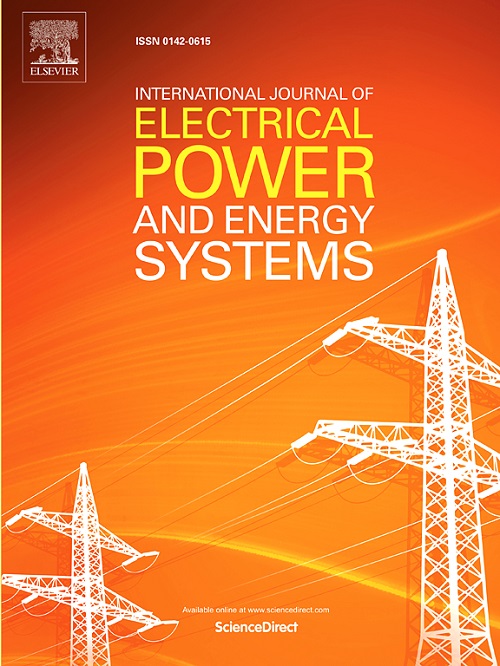分散优化,以协调当地能源社区在辅助服务市场的参与,期望能源共享和成本
IF 5
2区 工程技术
Q1 ENGINEERING, ELECTRICAL & ELECTRONIC
International Journal of Electrical Power & Energy Systems
Pub Date : 2025-05-09
DOI:10.1016/j.ijepes.2025.110694
引用次数: 0
摘要
为社区成员和电网运营商实现与本地能源社区(LECs)相关的多重利益,需要通过社区间协调、优化虚拟能源共享和辅助服务(AS)提供先进的能源管理。这项任务具有挑战性,因为必须在考虑全球需求的同时考虑当地需求;单独来看,每个LEC可能无法保证足够的电力灵活性,通过多个社区的协调努力,这是可行的。本文提出了一种新的基于分散优化的社区间协调方法,以保证多个lec在AS市场中的共同参与。拟议的协调方法认为,如意大利条例所规定的,自动服务提供的报酬与与分享能源的奖励有关的收入相结合,是一种目标函数,而能源成本则被认为是一种限制。此外,所提出的方法允许LEC管理者评估点对点(P2P)能源交换对LEC协调的影响、虚拟能源共享的激励和AS提供的报酬。通过多个案例分析,对该方法进行了性能评价,结果表明,该方法在保持能源共享接近理想值和能源成本不变的情况下,对社区间的协调是有效的。每个LEC的P2P能源交换倾向于降低能源成本和提高自耗电量,而其对提供的灵活性的影响取决于光伏能源生产。在分散优化得到的协调管理下,每个LEC的目标函数保持在其理想解的大约1%以内。在夏季的情况下,联合灵活性将每个社区的经济目标分别从大约659欧元至745欧元增加到2154欧元和1601欧元,强调了辅助服务的收入可以很容易地弥补共享能源激励的任何减少。在冬季,由于光伏发电量较低,灵活性收入减少,但社区仍保持在其最佳本地目标的1%以内,进一步证明了该方法的有效性。本文章由计算机程序翻译,如有差异,请以英文原文为准。
Decentralized optimization for coordinated participation of local energy communities in ancillary services markets with desired energy sharing and costs
Achieving the multiple benefits associated with Local Energy Communities (LECs) for both community members and grid operators requires advanced energy management through inter-community coordination, optimizing virtual energy sharing and ancillary service (AS) provision. This task is challenging because local requirements must be considered alongside global ones; individually, each LEC might be unable to guarantee sufficient power flexibility, which becomes feasible through coordinated efforts among multiple communities. This paper presents a novel inter-community coordination method, based on decentralized optimization to ensure the joint participation of multiple LECs in the AS market. The proposed coordination method considers as objective function the remuneration for AS provision combined with revenues associated with the incentives for the energy shared as established by the Italian regulation, while energy costs are considered as a constraint. In addition, the proposed method allows the LEC manager to assess the impact of peer-to-peer (P2P) energy exchanges on the coordination of LECs, the incentives for virtual energy sharing and the remuneration for AS provision. Multiple case studies are analyzed to evaluate the performance of the proposed method for two LECs, and the results demonstrate its effectiveness for inter-communities’ coordination while keeping the energy shared close to the desired value and the energy costs unchanged. P2P energy exchanges in each LEC tend to reduce energy costs and increase the self-consumption rate, while their impact on the provided flexibility depends on PV energy production. Under a coordinated management obtained with the proposed decentralized optimization, each LEC’s objective function remains within roughly 1 % of its ideal solution. In summer scenarios, joint flexibility increases each community’s economic objective from approximately €659–€745 to €2154 and €1601, respectively, highlighting that revenue from ancillary services can easily compensate for any reductions in shared-energy incentives. In winter scenarios, with lower PV energy production, flexibility revenues decrease, yet the communities remain within 1% of their optimal local targets, further demonstrating the method's effectiveness.
求助全文
通过发布文献求助,成功后即可免费获取论文全文。
去求助
来源期刊
CiteScore
12.10
自引率
17.30%
发文量
1022
审稿时长
51 days
期刊介绍:
The journal covers theoretical developments in electrical power and energy systems and their applications. The coverage embraces: generation and network planning; reliability; long and short term operation; expert systems; neural networks; object oriented systems; system control centres; database and information systems; stock and parameter estimation; system security and adequacy; network theory, modelling and computation; small and large system dynamics; dynamic model identification; on-line control including load and switching control; protection; distribution systems; energy economics; impact of non-conventional systems; and man-machine interfaces.
As well as original research papers, the journal publishes short contributions, book reviews and conference reports. All papers are peer-reviewed by at least two referees.

 求助内容:
求助内容: 应助结果提醒方式:
应助结果提醒方式:


